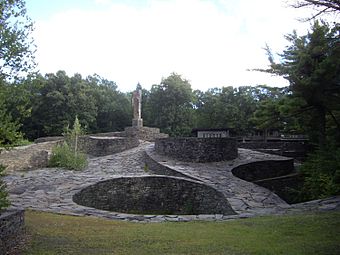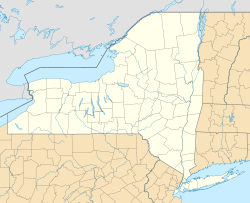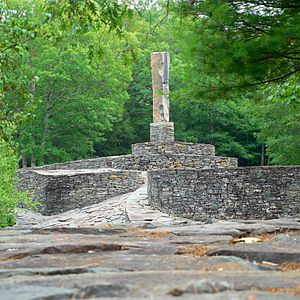Opus 40 facts for kids
Quick facts for kids |
|
|
Opus 40
|
|
 |
|
| Location | Fite Rd., Saugerties, NY |
|---|---|
| Area | 14.1 acres (5.7 ha) |
| Built | 1939-1976 |
| Architect | Harvey Fite |
| NRHP reference No. | 01000238 |
| Added to NRHP | March 12, 2001 |
Opus 40 is a huge outdoor sculpture located in Saugerties, New York. It was created by a sculptor named Harvey Fite (1903—1976). This amazing artwork is made from many ramps, pedestals, and platforms built using a special method called dry-stone construction. It covers about 6.5 acres (2.6 hectares) of an old bluestone quarry.
How Opus 40 Was Built
Harvey Fite was a professor of sculpture and theater at Bard College. In 1938, he bought an old quarry site. He planned to use the stone from the quarry for his sculptures. However, after working to restore ancient Mayan ruins in Honduras, he got a new idea.
He decided to create a special outdoor space to show his large stone statues. He used the leftover rocks from the quarry to build terraces, ramps, and walkways. He did all the work by hand, using the same traditional hand tools that local quarry workers used.
As his outdoor gallery grew, a 1.5-ton (1.36 metric ton) statue called Flame started to look too small. So, Fite replaced it with a much larger 9.5-ton bluestone pillar. He found this huge stone in a nearby streambed. Fite put up this main pillar in 1964, 25 years after he started his project.
At first, Fite wanted to carve the big river stone. But once it was in place, he realized something important. The setting he was building for his sculptures had become a complete sculpture on its own! It was a new kind of art where carved statues didn't quite fit. So, Fite moved his other sculptures to different spots on the surrounding land. He kept working on this new type of sculpture for the rest of his life.
In the early 1970s, after retiring from Bard College, Fite built the Quarryman's Museum on the property. This museum has a collection of old tools and items from the time when the quarry was active. Around this time, he also decided to give his masterpiece a name. He joked that composers just number their works, like "Opus One." So, he chose "Opus 40." "Opus" is a Latin word meaning "work." The "40" referred to the number of years he thought it would take him to finish the project.
Sadly, Harvey Fite passed away on May 9, 1976. He had an accidental fall while working on Opus 40. He was in the 38th year of his creation. Work stopped that day, leaving some parts unfinished. His stepson, Jonathan Richards, said that Opus 40 was "as complete as it ever would have been." He meant that it was a project that would only stop when Fite's life did.
The next year, Fite's wife, Barbara Fite, created a non-profit group to take care of Opus 40. She opened the grounds to the public to help pay for its upkeep. Barbara Fite passed away in 1987. Her son, Tad Richards, and his wife, Pat, then looked after Opus 40 for many years. Today, family members still help guide the organization. Opus 40 is still a popular place to visit. It also hosts weddings and concerts. In 2001, it was added to the National Register of Historic Places.
Why Opus 40 is Special
Brendan Gill, a famous writer, called Opus 40 "one of the largest and most amazing works of art on the entire continent." He also said it was "the greatest earthwork sculpture I have ever seen." Harvey Fite was not part of the Land Art movement that became popular in the 1970s. However, he is now seen as a pioneer, or someone who started, that movement. In 1977, the Hirshhorn Museum of the Smithsonian Institution recognized him for his early work in earth art.
Opus 40 in Pop Culture
- A Sonny Rollins concert at Opus 40 on August 16, 1986, was filmed for a documentary called Saxophone Colossus.
- The band Mercury Rev recorded a song called "Opus 40" about the site. It is on their 1998 album Deserter's Songs.
- The music video for Amanda Palmer's version of Pink Floyd's song "Mother" was filmed at Opus 40 in 2017.




